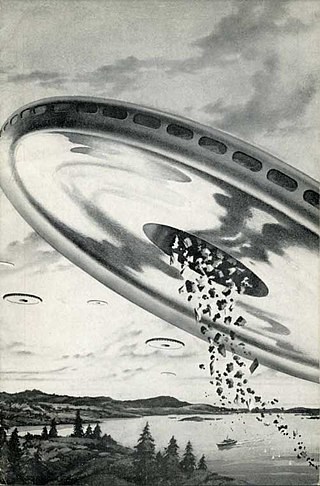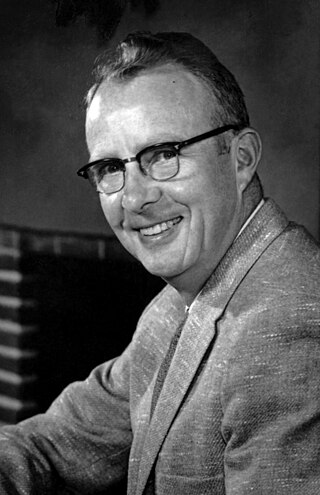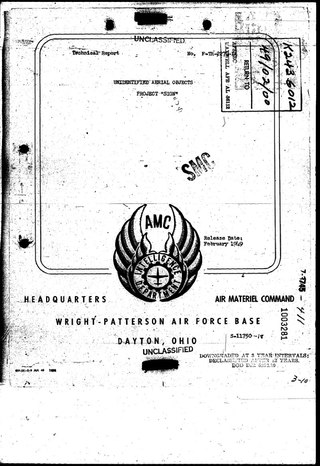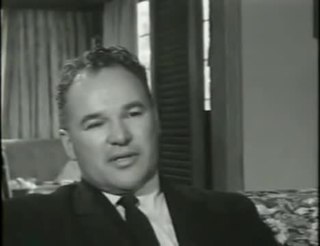
An unidentified flying object (UFO), or unidentified anomalous phenomenon (UAP), is any perceived airborne, submerged or transmedium phenomenon that cannot be immediately identified or explained. Upon investigation, most UFOs are identified as known objects or atmospheric phenomena, while a small number remain unexplained.

Hector International Airport is a civil-military public airport three miles (5 km) northwest of Fargo, in Cass County, North Dakota, United States. The busiest airport in North Dakota, it is owned by the City of Fargo Municipal Airport Authority. Fargo Air National Guard Base is located adjacent to the airport.

The Roswell incident is a conspiracy theory which alleges that the 1947 United States Army Air Forces balloon debris recovered near Roswell, New Mexico, was actually a crashed extraterrestrial spacecraft. Operated from the nearby Alamogordo Army Air Field and part of the top secret Project Mogul, the balloon was intended to detect Soviet nuclear tests. After metallic and rubber debris were recovered by Roswell Army Air Field personnel, the United States Army announced their possession of a "flying disc". This announcement made international headlines, but was retracted within a day. To obscure the purpose and source of the debris, the army reported that it was a conventional weather balloon.

Project Blue Book was the code name for the systematic study of unidentified flying objects by the United States Air Force from March 1952 to its termination on December 17, 1969. The project, headquartered at Wright-Patterson Air Force Base, Ohio, was initially directed by Captain Edward J. Ruppelt and followed projects of a similar nature such as Project Sign established in 1947, and Project Grudge in 1949. Project Blue Book had two goals, namely, to determine if UFOs were a threat to national security, and to scientifically analyze UFO-related data.
On 7 January 1948, 25-year-old Captain Thomas F. Mantell, a Kentucky Air National Guard pilot, died when he crashed his P-51 Mustang fighter plane near Franklin, Kentucky, United States, after being sent in pursuit of an unidentified flying object (UFO). Mantell pursued the object in a steep climb and disregarded suggestions to level his altitude. At high altitude, he blacked out from a lack of oxygen; his plane went into a downward spiral and crashed. The incident was among the most publicized of early UFO reports. Later investigation by the United States Air Force's Project Blue Book indicated that Mantell died chasing a Skyhook balloon, which, in 1948, was a top-secret project that he would not have known about.

The Maury Island incident refers to claims made by Fred Crisman and Harold Dahl of falling debris and threats by men in black following sightings of unidentified flying objects in the sky over Maury Island, Washington, United States. The pair claimed that the events had occurred on June 21, 1947. The incident is widely regarded as a hoax, even by believers of flying saucers and UFOs.

The Robertson Panel was a scientific committee which met in January 1953 headed by Howard P. Robertson. The Panel arose from a recommendation to the Intelligence Advisory Committee (IAC) in December 1952 from a Central Intelligence Agency (CIA) review of the U.S. Air Force investigation into unidentified flying objects, Project Blue Book. The CIA review itself was in response to widespread reports of unidentified flying objects, especially in the Washington, D.C. area during the summer of 1952.
The Lubbock Lights were an unusual formation of lights seen over the city of Lubbock, Texas in August and September 1951. The Lubbock Lights incident received national publicity in the United States as a UFO sighting, and was investigated by the U.S. Air Force. According to Captain Edward J. Ruppelt, "Officially all of the sightings, except the UFO that was picked up on radar, are unknowns."

Project Sign or Project Saucer was an official U.S. government study of unidentified flying objects (UFOs) undertaken by the United States Air Force (USAF) and active for most of 1948. It was the precursor to Project Grudge.

Project Grudge was a short-lived project by the U.S. Air Force (USAF) to investigate unidentified flying objects (UFOs). Grudge succeeded Project Sign in February, 1949, and was then followed by Project Blue Book. The project formally ended in December 1949, but continued in a minimal capacity until late 1999.

The Mariana UFO incident occurred in August, 1950 in Great Falls, Montana. The sighting, filmed by local baseball coach Nick Mariana, is believed to be among the first ever motion picture footage of what came to be called an unidentified flying object (UFO). The U.S. Air Force, after a short investigation, concluded that what Mariana had actually filmed were the reflections of two F-94 jet fighters, a claim that the Air Force would later retract.
The Chiles-Whitted UFO encounter occurred at approximately 2:45 AM on July 24, 1948, in the skies near Montgomery, Alabama, United States. Two commercial pilots, Clarence S. Chiles and John B. Whitted, claimed to have observed a "glowing object" pass by their plane before it appeared to pull up into a cloud and travel out of sight.

From July 12 to 29, 1952, a series of unidentified flying object (UFO) sightings were reported in Washington, D.C., and later became known as the Washington flap, the Washington National Airport Sightings, or the Invasion of Washington. The most publicized sightings took place on consecutive weekends, July 19–20 and July 26–27. UFO historian Curtis Peebles called the incident "the climax of the 1952 (UFO) flap"—"Never before or after did Project Blue Book and the Air Force undergo such a tidal wave of (UFO) reports." this went on to become one of the most known UFO sightings ever.
The Exeter incident or Incident at Exeter was a highly publicized UFO sighting that occurred on September 3, 1965, approximately 5 miles (8 km) south of Exeter, New Hampshire, in the neighboring town of Kensington. Although several separate sightings had been reported in the Exeter area by numerous witnesses in the weeks leading up to the specific incident, it was the September 3 sighting, involving a local teenager and two police officers which eventually became by far the most famous. In 2011, Skeptical Inquirer offered an explanation of the incident, based on details reported by the eyewitnesses.
The Lakenheath-Bentwaters Incident was a series of radar and visual contacts with unidentified flying objects over airbases in eastern England on the night of 13–14 August 1956, involving personnel from the Royal Air Force (RAF) and the United States Air Force (USAF). The incident has since gained some prominence in the literature of ufology and the popular media.
UFO is a 1956 American semi-documentary about the development of the UFO phenomenon in the United States. Clips from the documentary have often been used in other UFO documentaries and television episodes related to UFOs.

The Flight 105 UFO sighting occurred on July 4, 1947, when three crew members aboard a United Airlines flight reported seeing multiple unidentified flying objects in the skies over the Pacific Northwest. The incident was among at least 800 similar sightings in the United States within a few weeks in the summer of 1947, but the first report by professional pilots. The U.S. military ultimately attributed what the crew members saw to "ordinary aircraft, balloons, birds, or pure illusion".

The Report on Unidentified Flying Objects is a 1956 book by then-retired Air Force UFO investigator Edward J. Ruppelt, detailing his experience running Project Blue Book. The book was noted for its suggestion that a few UFO sightings might be linked to spikes of atomic radiation. Contemporary media summarized four topics discussed in the book:

"Have We Visitors From Space?" was an article on Flying Saucers by H. B. Darrach Jr. and Robert Ginna that appeared in the April 7, 1952 edition of Life magazine. The piece was strongly sympathetic to the hypothesis that UFOs might be the product of extraterrestrials. Publicity surrounding the piece is believed to have contributed to the 1952 UFO flap, a subsequent wave of reports that summer.
On the night of January 20, 1951, multiple individuals reported an unidentified cigar-shaped straight-winged aircraft over Sioux City, Iowa. By January 22, papers nationwide publicized had their reports. The incident continues to be discussed in the 21st-century.












